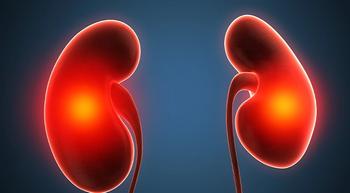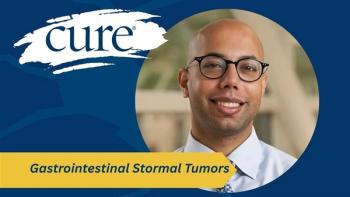
Tagrisso Plus Chemo Offers Survival benefit in EGFR+ NSCLC
Key Takeaways
- Tagrisso combined with chemotherapy improved overall survival in EGFR-mutated NSCLC patients, including those with poor prognostic factors, compared to Tagrisso alone.
- The FLAURA2 trial demonstrated significant survival benefits across subgroups, including patients with CNS, bone, and liver metastases.
Among patients with EGFR-mutated non-small cell lung cancer Tagrisso plus chemotherapy was associated with an improvement in survival.
Among patients with EGFR-mutated non-small cell lung cancer, including those with poor prognostic factors, treatment with Tagrisso (osimertinib) with platinum-based chemotherapy and pemetrexed was associated with an improvement in survival compared with Tagrisso alone across subgroups, according to data from an exploratory analysis of the phase 3 FLAURA2 trial.
Previously reported data from the trial’s final overall survival (OS) analysis showed that patients treated with Tagrisso plus chemotherapy (279 patients) achieved a median OS of 47.5 months versus 37.6 months for those treated with Tagrisso alone (278 patients).
The exploratory analysis, which was presented at the 2025 ESMO Congress, examined outcomes for patients based on the following six prognostic factors:
- Central nervous system (CNS) metastases
- Bone metastases
- Liver metastases
- EGFR mutation status
- TP53 status
- Plasma EGFR mutations in circulating tumor DNA
“Hazard ratios for OS favored the combination arm, regardless of baseline prognostic factors, and were consistent with the overall population,” lead study author Dr. Pasi A. Jänne said in a presentation of the data. Jänne is a senior physician, senior vice president for Translational Medicine, director of the Belfer Center for Applied Cancer Science, director of the Chen-Huang Center for EGFR Mutant Lung Cancers, and the David M. Livingston, MD, Chair at Dana-Farber Cancer Institute, as well as a professor of medicine at Harvard Medical School in Boston.
What Were the FLAURA2 OS Outcomes by Prognostic Subgroup?
In patients harboring CNS metastases at baseline, the median OS was 40.9 months for Tagrisso plus chemotherapy (116 patients) compared with 29.7 months for Tagrisso monotherapy (110 patients). The three-year OS rates in this subgroup were 57% and 40%, respectively. In patients without CNS metastases at baseline, the median OS was not reached for Tagrisso plus chemotherapy (163 patients) versus 43.9 months for Tagrisso alone (168 patients).
Patients harboring EGFR exon 21 L858R mutations treated with Tagrisso plus chemotherapy (106 patients) achieved a median OS of 38.1 months versus 32.4 months for Tagrisso alone (107 patients). The respective three-year OS rates were 54% and 42%. In patients harboring EGFR exon 19 deletions, the median OS was not reached for Tagrisso plus chemotherapy (172 patients) versus 43 months for Tagrisso alone (169 patients).
Among patients with EGFR mutations detected in plasma ctDNA, the median OS was 38.4 months for Tagrisso plus chemotherapy (148 patients) versus 32.5 months for Tagrisso monotherapy (161 patients). The three-year OS rates in this subgroup were 53% for Tagrisso plus chemotherapy versus 42% for Tagrisso alone. In patients without EGFR mutations detected in plasma ctDNA, the median OS was not reached and not reached for the combination (65 patients) and Tagrisso monotherapy (48 patients), respectively.
In the subgroup of patients with liver metastases at baseline, Tagrisso plus chemotherapy (43 patients) generated a median OS of 36.6 months compared with 28 months for Tagrisso alone (66 patients). The three-year OS rates were 54% and 35%, respectively. In patients without liver metastases at baseline, the median OS was 49.6 months for Tagrisso plus chemotherapy (236 patients) versus 41.8 months for Tagrisso alone (212 patients).
For patients with bone metastases, the median OS was 40.2 months for Tagrisso plus chemotherapy (132 patients) versus 32.3 months for Tagrisso monotherapy (142 patients). The three-year OS rates were 55% and 42%, respectively. In patients without bone metastases, the median OS was not reached and 44.5 months for Tagrisso plus chemotherapy (147 patients) and Tagrisso alone (136 patients), respectively.
Finally, in patients harboring TP53 alterations, those given Tagrisso plus chemotherapy (46 patients) experienced a median OS of 51.1 months versus 43.1 months for those administered Tagrisso alone (40 patients). The three-year OS rates were 65% and 58%, respectively. In patients with TP53 wild-type disease, the median OS was not reached for Tagrisso plus chemotherapy (33 patients) and not reached for Tagrisso alone (34 patients).
How Was the FLAURA2 Trial Designed?
Notably, prior data from this study supported the February 2024 FDA approval of Tagrisso plus platinum-based chemotherapy for use in patients with locally advanced or metastatic NSCLC harboring EGFR exon 19 deletions or exon 21 L858R mutations, as detected by an FDA-approved test.
FLAURA2 enrolled patients at least 18 years of age with previously untreated, pathologically confirmed locally advanced or metastatic nonsquamous NSCLC harboring EGFR exon 19 deletions or exon 21 L858R mutations. Patients were also required to have a World Health Organization performance status of 0 or 1. Patients with stable CNS metastases were allowed to enroll, and brain scans were mandatory at baseline.
Patients were randomly assigned to receive Tagrisso at 80 mg per day in combination with pemetrexed at 500 mg/m2 and carboplatin at area under the curve 5 or cisplatin at 75 mg/m2 once every three weeks for four cycles, followed by Tagrisso at 80 mg once per day plus pemetrexed at 500 mg/m2 once every three weeks as maintenance therapy; or Tagrisso alone at 80 mg per day. Treatment beyond disease progression was permitted at investigator discretion.
References
- “FLAURA2: exploratory overall survival analyses in patients with poorer prognostic factors treated with osimertinib ± platinum-pemetrexed as first-line treatment for EGFR-mutated advanced NSCLC,” by Dr. Pasi A. Jänne, et al. Presented at: 2025 ESMO Congress; October 17-21, 2025; Berlin, Germany. Abstract LBA77.
- “Tagrisso plus chemotherapy demonstrated a median overall survival of nearly four years, the longest benefit ever reported in a global Phase III trial in EGFR-mutated advanced lung cancer,” news release; https://www.astrazeneca.com/media-centre/press-releases/2025/tagrisso-plus-chemotherapy-demonstrated-a-median-overall-survival-of-nearly-four-years.html
- “FDA approves osimertinib with chemotherapy with chemotherapy for EGFR-mutated non-small cell lung cancer,” FDA; https://www.fda.gov/drugs/resources-information-approved-drugs/fda-approves-osimertinib-chemotherapy-egfr-mutated-non-small-cell-lung-cancer
For more news on cancer updates, research and education,





